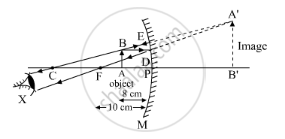Advertisements
Advertisements
Question
If an object is placed at a distance of 8 cm from a concave mirror of focal length 10 cm, discuss the nature of the image formed by drawing the ray diagram.
Solution

As shown in the diagram, the image formed is
- behind the mirror
- virtual and erect
- larger than the object
APPEARS IN
RELATED QUESTIONS
State where an object must be placed so that the image formed by a concave mirror is:
(b) at infinity.
(c) the same size as the object.
Name the type of mirror used by dentists. How does it help?
What is the position of the image when an object is placed at a distance of 20 cm from a concave mirror of focal length 20 cm?
Describe the nature of image formed when the object is placed at a distance of 20 cm from a concave mirror of focal length 10 cm
What would your image look like if you stood close to a large:
concave mirror?
The mirror which can form a magnified image of an object is:
(a) convex mirror
(b) plane mirror
(c) concave mirror
(d) both convex and concave mirror
Suppose you have three concave mirrors A, B and C of focal lengths 10 cm, 15 cm and 20 cm. For each concave mirror you perform the experiment of image formation for three values of object distance of 10 cm, 20 cm and 30 cm. Giving reason answer the following:
(a) For the three object distances, identify the mirror/mirrors which will form an image of magnification – 1.
(b) Out of the three mirrors identify the mirror which would be preferred to be used for shaving purposes/makeup.
(c) For the mirror B draw ray diagram for image formation for object distances 10 cm and 20 cm.
A 10 mm long awl pin is placed vertically in front of a concave mirror. A 5 mm long image of the awl pin is formed at 30 cm in front of the mirror. The focal length of this mirror is ______.
State whether the following statement is True or False
The sides of an object and its image formed by a concave mirror are always interchanged.
